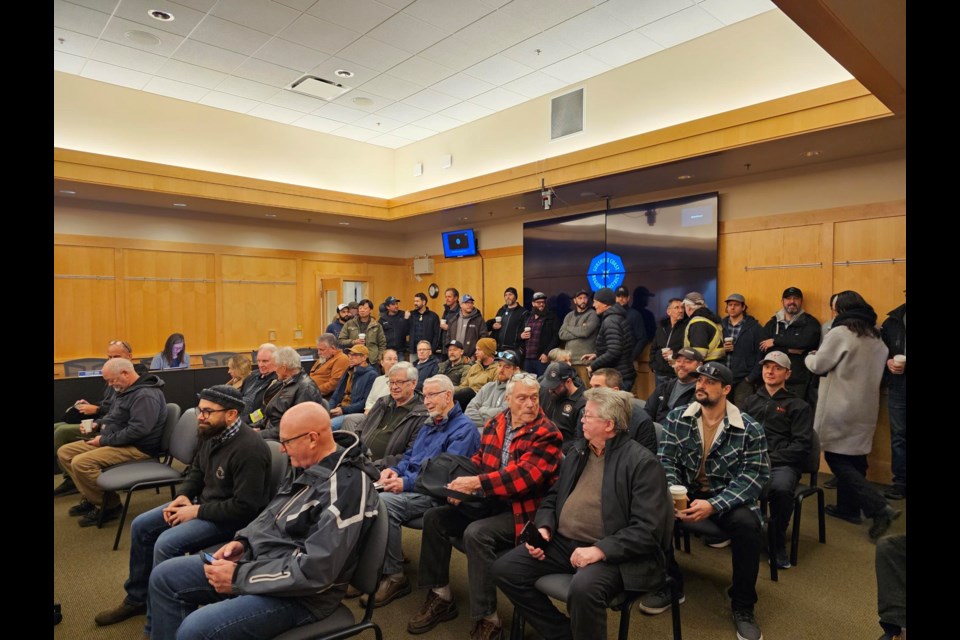Fearing building project shut downs, more than 100 people with links to the Coast’s development community showed up to demand immediate “correction” to what that group called local government "overreaction” at a Jan 11 Sunshine Coast Regional District (SCRD) committee meeting. That followed the receipt of preliminary water infrastructure modelling showing regional water infrastructure firefighting flow levels are outdated.
At its meeting later that day, the Sunshine Coast Regional District (SCRD) board responded with an ask to staff to draft bylaw amendments to align fire flow rates for developments to match its current practices. With that direction provided, staff can resume consideration of development permits, which they had proposed be delayed.
Keeping with the most recent practice means developments in rural SCRD areas that have fire protection services would need to have minimum flows of 30 litres per second available. In the higher density locations (mostly within Sechelt) the base level would be 60 litres per second. The SCRD's bylaw states all developments require 60 litres per second flows, so an amendment is needed to make the current practice compliant with its own written regulations.
That board action partially satisfied what the contingent of building and business sector representatives was seeking. Following that vote, group spokesperson Bruce Mason of Westcor Lands told Coast Reporter via email, "We feel that we were heard and are hoping this was a good first step in the process."
A staff report added as a late committee meeting agenda item stated that preliminary water system modelling “indicated that current fire flows are not being met in a substantial part of the SCRD water systems." Staff suggested development approvals be delayed, given those levels were lower than recommended in the 2020 Water Supply for Public Fire Protection and Master Municipal Construction Document Design Guidelines. Those call for flows ranging from 60 to 225 litres per second, lowest for residential and highest for industrial-type developments. It was explained by staff that while there is no requirement for the SCRD to set its levels to meet higher levels, efforts toward meeting those were a "best practice" to ensure public safety.
In committee discussion, chairperson and Area E director Donna McMahon asked “How realistic is it that we (the SCRD) have the same [fire flow] standard as Vancouver?” and her committee counterparts unanimously supported a recommendation to the board to maintain the status quo on those requirements pending further review.
End the 'hold' on development
The second item that the group attending on Jan. 11 called for was an immediate end to the “hold” the District of Sechelt recently placed on development application servicing reviews. Public attendees of the meeting called Sechelt's action an “overreach." They said it was causing project delays that would have “dire economic consequences” for the Coast and that the construction community is experienced at building much-needed housing that is safe with the existing hydrant fire flow levels.
“We are not putting up with having development stopped, we’re going to Victoria next,” Steve Dutton of Westcor Lands stated at the meeting. Dutton, whose firm helped coordinate the group’s efforts, also sent a Jan. 10 email to B.C. Premier David Eby requesting provincial help with the situation.
While supported with applause that the SCRD event, the call for Sechelt to change its orders will require the municipality to make that adjustment. The industry and business group told Coast Reporter they plan to make that ask of Sechelt council at its Jan 17 regular meeting.
Next steps for the SCRD
On Jan. 25, the SCRD is slated to consider a further committee-level report on water modelling. That is to include maps showing the levels of water flows available throughout all areas on the region’s water supplies.
Directors suggested there be consultation with the development community and the general public about where the region should focus when it comes to balancing how to pay for fire flow enhancements and other pressing infrastructure priorities. During discussions, staff outlined how setting standards for land development is "a challenge and an opportunity." While providing a high level of fire protection infrastructure as the community grows may be something to strive for, the realities of putting those in place are complex and doing it right will take time and resources. With that before them, directors also agreed to look at an additional 2024 budget proposal for staffing and other costs of doing that work at the Feb. 5’s Round 2 budget debate.
The need to find ways to support the building of more housing on the Coast was raised by several of the officials at the committee table.
Background
Conversations in the local construction community about potential delays for developments started to surface with a Dec. 13, 2023, SCRD letter to area developers. The letter stated that the modelling used in all SCRD water distribution systems was over 10 years old and that much of the existing infrastructure like water mains, hydrants and pump stations, were built based on “outdated standards."
The letter stated, “While the SCRD is awaiting the final water model report, initial findings have indicated a need for major upgrades to some water infrastructure in the Region. This may have an impact on some proposed developments."
Westcor and other developers also received a message from the District of Sechelt planning department in December, stating "All development application servicing reviews are now on hold."
Correction: An earlier version of this story attributed the communication from the District of Sechelt as coming from CAO Andrew Yeates. The message in fact came from Sechelt's planning department. We regret the error.



